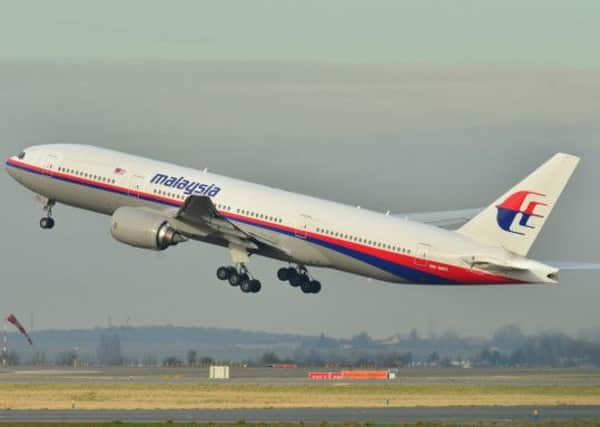Missing jet: Warning over fuselage cracks


A Federal Aviation Administration (FAA) directive cautioned that, unless airlines acted, their Boeing 777 aircraft could suffer “rapid decompression and loss of structural integrity”.
As the search goes on for Malaysia Airlines flight MH370, which left Kuala Lumpur on Saturday bound for Beijing, the FAA warning has prompted suggestions the plane may have developed problems in the air.
Advertisement
Hide AdAdvertisement
Hide AdA gradual decline in oxygen levels as it gained altitude may have gone unnoticed by the crew until it was too late and they became disorientated, or a sudden decompression may have caused the jet to explode.
In the FAA airworthiness directive, issued on 18 September, airlines were given a deadline of 9 April to “detect and correct cracking and corrosion in the fuselage skin” underneath the “satellite communication antenna adaptor” on the aircraft.
The alert said one airline had found a 16in crack in the fuselage of one of its Boeing 777s.
There are about 900 Boeing 777s operated by more than 60 airlines around the world.
Boeing said the FAA alert did not apply to the type of jet used for flight MH370 as it had a different antenna to the rest of the 777 range, but aviation experts questioned whether the faults highlighted in the directive may have played a part in the plane’s disappearance.
Mary Schiavo, a former inspector general at the US department of transportation, said: “The warning said the 777 had a problem with fuselage cracking. I wonder what didn’t get done. If this plane had a problem and it had cracking or some sort of a rapid decompression and lost the ability to communicate, it would make perfect sense.”
Passengers’ relatives are ramping up pressure on the Malaysian and Chinese governments to give them answers about what has happened, threatening lawsuits and demanding to see Chinese president Xi Jinping.
One man from Beijing, speaking to reporters after a meeting between the families and Malaysian diplomats, said it was ridiculous the Malaysians seemed to have no information about even the most basic facts.
Advertisement
Hide AdAdvertisement
Hide AdThe talks took place as Malaysian authorities again expanded their search into the Andaman Sea and beyond, after acknowledging the plane could have flown for several hours after its last contact with the ground. That scenario would make finding the plane much more difficult, and it raises the possibility searchers are looking in the wrong place for the aircraft and its 239 passengers and crew.
In the latest in a series of false leads, planes were sent to search an area where satellite images published on a Chinese government website reportedly showed three suspected floating objects off the southern tip of Vietnam. “There is nothing. We went there, there is nothing,” acting Malaysian transport minister Hishammuddin Hussein said.
Compounding the frustration, he later said the Chinese Embassy had notified the government that the images had been released by mistake and did not show any debris from the Malaysia Airlines flight.
An international search effort is sweeping the South China Sea and the Strait of Malacca because of unconfirmed military radar sightings that might indicate the plane changed course and headed west after its last contact.
US investigators suspect it remained in the air for about four hours after its last confirmed contact, citing data from the plane’s engines that is automatically transmitted to the ground as part of a routine maintenance programme.
Mr Hishammuddin said the government had contacted Boeing and engine maker Rolls-Royce, and both said the last data had been received at 1:07am – 23 minutes before the plane lost contact. Asked if it were possible it had kept flying for several hours, he said: “Of course, we can’t rule anything out.”
He said the search had been widened into the Andaman Sea. Malaysia is asking for radar data from neighbouring countries, and India plans to deploy planes and ships in the southern section of the sea.
Investigators have not ruled out any possible cause. Experts say a massive failure knocking out its electrical systems, while unlikely, could explain why its transponders, which identify it to civilian radar systems and other planes nearby, were not working. Another possibility is that the pilot, or a passenger, switched off the transponders in the hope of flying undetected.